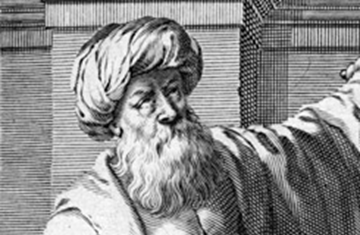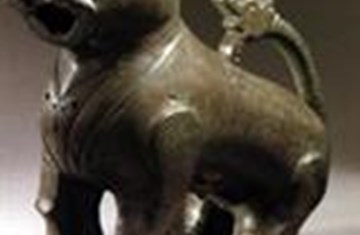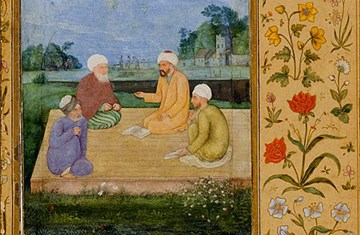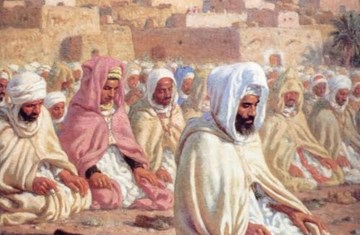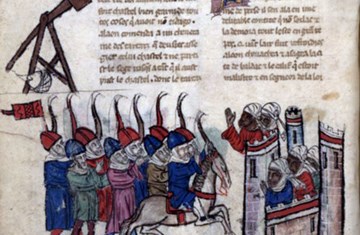Salamiyya
Salamiyya, a town in central Syria in the district of Orontes (Nahr al-‘Asi), about 25 miles south east of Hamat and 35 miles north-east of Hims (for the town’s exact situation, see Kiepert’s map in M. von Oppenheim, Vom Mittelmeer zum Persischen Golf, Berlin 1899, i, 124 ff., and ii, 401; National Geographic Atlas of the World, 5th ed., Washington D.C. 1981, 178-9). Salamiyya lies in a fertile plain 1,500 feet above sea level, south of the Jabal al-A‘la and on the margin of the
Syrian steppe. The older and more correct pronunciation of the town’s name was Salamya, but the form Salamiyya is also found very early and is now the form almost universally in use (cf. Yakut, Mu‘jam al Buldan, iii, 123; Littmann, Semitic inscriptions, 169 ff.) The nisba from the name is Salami. The town seems to be the ancient Salamias or Salaminias, which flourished in
the Christian period, but the references of the classical authors to this place are uncertain. Yakut gives a popular etymology. The town, he says, was originally called Salam-mi’a, after the hundred surviving inhabitants of the destroyed town of al-Mu’tafika; the survivors then settled in Salamiyya and rebuilt it.
The situation of the town was important as an outpost of Syria, where main routes from the steppe (Palmyra) and Iraq joined; but it was never of any great military importance. Salamiyya was conquered by the Arabs in the year 15 AH (636 CE), and became one of the towns of the Djund of Hims; it was only after 906 AH (1500 CE) in the Mamluk period that it was placed in the district of Hamat for administrative purposes.
During the 2nd century AH (8th century CE), soon after the victory of the Abbasids, the Abbasid Salih b.‘Ali b.‘Abd Allah al-‘Abbas, and later some of his descendants, settled in Salamiyya. In 141 AH (758 CE), Salih b.‘Ali had been appointed as the governor of southern and central Syria, and he paid some attention to reconstructing Salamiyya. The town is said to have been most indebted to Salih’s son ‘Abd Allah, who rebuilt it and developed the irrigation system of the locality and its environs. This ‘Abd Allah was held in high esteem by his cousins, the first two Abbasid caliphs. On his way to Jerusalem in 163 AH (779-80 CE), the caliph al-Mahdi stayed with ‘Abd Allah in Salamiyya and admired his house (al-Tabari, iii, 500, tr. H. Kennedy, The History of al-Tabari , xxix, Mansur and Mahdi, Albany 1990, 215). In this same year, ‘Abd Allah, who had meanwhile married al-Mahdi’s sister, was appointed as the governor of al-Jazira. There are more scattered references to the fact that many Abbasid Hashimids lived in Salamiyya from early Abbasid times (see, for instance, al-Nisaburi, Istitar al-imam, 115 ff., 123-5, tr. Ivanow in his Ismaili Tradition, 160 ff., 171-3; Ibn Hazm, Djamharat al-ansab al-‘Arab, ed. ‘Abd Salam M. Harun, Cairo 1391 AH (1971 CE), 20; Idris ‘Imad al-Din, Uyun al-akhbar, iv, 365, 402).
Almost nothing has survived in Salamiyya from this early Abbasid period. There is the foundation inscription of a mosque on a stone (not in situ) at the entrance to the citadel. It is probable that this inscription is dated 150 AH (767-8 CE) and it belonged to a mosque founded by those Abbasids, which may have been destroyed later (about 290 AH (903CE)) by the Qarmatis who invaded the town. Still another inscription stemming from an Abbasid has been found in the citadel; according to Littmann’s plausible suggestion, it belongs with two other inscriptions to the period from 280 AH (893-4 CE) (or, for another view, see Hartmann, Die arabischen Inschriften, 55).
The fact that Salamiyya was the centre of an important branch of the Hashimids and the isolated position of the town perhaps account for its important role in the early history of the Ismaili movement as the secret headquarters of the pre-Fatimid Ismaili da‘wa. According to the later Ismailis, the early Ismaili da‘wa was organised and led by a number of imams who were descendants of the Shi‘a Imam Ja‘far al-Sadiq. It was Imam ‘Abdallah, a great-grandson of Imam al-Sadiq who, after living in different localities in Khuzistan and Iraq, fled to Syria and eventually settled down in Salamiyya at an unknown date around the beginning of the 3rd century AH (9th century CE). At the time, Salamiyya was held by the Abbasid Muhammad b.‘Abd Allah b. Salih, who had transformed the town into a flourishing commercial centre. The ‘Alid Imam ‘Abdallah, the Ismaili leader who then posed as an ordinary Hashimid and a merchant, was granted permission by the Abbasid lord of the town to settle there; later, he built a sumptuous palace for himself in Salamiyya which evidently continued to be used by his descendants and successors as the central leaders of the Ismaili da‘wa (see al-Nisaburi, 116 ff., tr. Ivanow, 161 ff.; Idris Imad al-Din, iv, 357-66). Salamiyya served as the headquarters of the Ismaili movement until the year 289 AH (902 CE); it was from there that da‘is were originally dispatched for propagating the Ismaili teachings and initiating the da‘wa in different regions. These activities were greatly intensified around the middle of the 3rd century AH (9th century CE).
Imam ‘Abdallah, the future Fatimid Imam-Caliph al-Mahdi, was born in Salamiyya in 259 or 260 AH (873-4 CE). In 286 AH (899 CE), not long after his accession to the central leadership of the Ismailis, Imam ‘Abdallah introduced some important changes into the doctrines propagated by the early Ismaili da‘wa. However, the new instructions issued from Salamiyya were not endorsed by certain regional da‘is, notably Hamdan Karmat and his chief assistant ‘Abdan, who led the da‘wa in Iraq and adjacent areas. ‘Abdan was dispatched on a fact-finding mission to Salamiyya. Having become convinced of Imam ‘Abdallah’s reform, Hamdan and ‘Abdan broke away from the central leadership; the dissident view found supporters also in Bahrayn and some eastern Ismaili communities. The Ismailis were now split into two rival factions, the dissident Qarmatis and the loyal Fatimid Ismailis (see W. Madelung, Das Imamat in der frühen ismailitischen Lehre, in Der Islam , xxxvii [1961], 65-86; F. Daftary, A major schism in the early Isma‘ili movement, in SI, lxxvii [1993], 123-39).
The da‘i Zikrawayh b. Mihrawayh, who had initially remained loyal to Imam ‘Abdallah, soon manifested his own rebellious intentions and led the Qarmati revolts of Iraq and Syria during 289-94 AH (902-7 CE) (H. Halm, Die Söhne Zikrawaihs und das erste fatimidische Kalifat 290/903, in Die Welt des Orients, x [1979], 30-53). Imam ‘Abdallah had already left Salamiyya a year before the rebellious Qarmatis, led by Zikrawayh’s sons, entered it in 290 AH (903 CE). The Qarmatis massacred the inhabitants of Salamiyya, also destroying Imam ‘Abdallah’s palace there. The success of the Qarmatis in Syria was, however, short-lived. By 291 AH (903 CE), the Qarmatis were severely defeated by an Abbasid army near Salamiyya; and their leader in Syria, one of Zikrawayh’s sons, was captured and taken before the Abbasid caliph al-Muktafi, who had him executed. Meanwhile, Imam ‘Abdallah had embarked on the fateful journey that took him to North Africa where he founded the Fatimid caliphate. It is not impossible that the quadrangular citadel in the centre of Salamiyya goes back to the Ismaili period of the town; according to van Berchem, it belongs to an early period architecturally.
In the 4th century AH (10th century CE), Salamiyya must have been in an area inhabited by Bedouins (Sayf al-Dawla’s campaign; cf. Hartmann, in Zeitschrift des Deutschen Palästinavereins, xxii [1899], 175, 176). At the end of the 5th century AH (11th century CE), it was included in the possessions of the brigand Khalaf b. Mula‘ib, who acknowledged Fatimid suzerainty. There is evidence of this in an inscription in Kufic characters, dated 481 AH (1088 CE), on the door beam of a mosque in Salamiyya. According to Ibn al-Athir (x, 184), Khalaf took Salamiyya in 476 AH (1083-4 CE); he was then already master of Hims. But in 485 AH (1092 CE), he lost Hims and the lands that went with it to the Saljuq Tutush, brother of Malik Shah (Ibn al-Kalanisi, Dhayl ta’rikh Dimashq, ed. H.F. Amedroz, Leiden 1908, 115, 120, 132, 149-50; Ibn Muyassar, Akhbar Misr, ed. A.F. Sayyid, Cairo 1981, 63, 76). In the inscription, studied extensively by Rey, Hartmann, van Berchem and Littmann, Khalaf says that he has erected this mashhad on the tomb of the qa’id Abu ’l-Hasan ‘Ali b. Jarir (or Ja‘far), whose servant (sani‘) he calls himself. However, the Syrian Ismailis have traditionally regarded this tomb as that of their early imam ‘Abd Allah, one of the imams of the pre-Fatimid period, calling the mausoleum locally as the maqam al-imam. H. Halm, who studied and reinterpreted the inscription in 1980, lends support to the local Syrian Ismaili tradition by holding that the mausoleum was in all probability originally erected, about 400 AH (1009 CE), over the tomb of the imam ‘Abdallah by the Kutami qa’id ‘Ali b. Ja‘far (b. Falah), the Fatimid commander who seized Salamiyya for the Fatimids and whose name appears in the inscription, and that Khalaf merely repaired the site, some four decades later (see Halm, Les Fatimides à Salamya, 144-7, with photographs of the site on 148-9).
During the Crusades, Salamiyya is never mentioned as a fortress but frequently as a meeting place for the Muslim armies. Politically it has always shared the fate of Hims. Thus it passed to Ridwan, son of Tutush, in 496 AH (11102-3 CE). In 532 AH (1137-8 CE), the Atabeg Zanki b. Ak Sunkur, who was then besieging Hims, set out from Salamiyya on his campaign against the Greeks at Shayzar (Ibn al-Athir, xi, 36ff.), and in 570 AH (1174-5 CE) Salah al-Din obtained the town together with Hims and Hamat from the amir Fakhr al-Din al-Za‘farani (ibid., xi, 276). In 626 AH (1229 CE), we find the Ayyubid al-Malik al-Kamil I in Salamiyya as a staging-post for Iraq; the lord of Hamat came there to submit to him. Two years later, al-Kamil gave the town to Asad al-Din Shirkuh, who rebuilt the fortress of Shumaymish north of it on one of the peaks of the Jabal al-A‘la (ibid., xii, 318, 329; van Berchem and Fatio, Voyage en Syrie, i, 171, 173) which had been destroyed by the earthquake of 552 AH (1157 CE) (Ibn al-‘Adim, Zubdat al halab min ta’rikh Halab, i, ed. S. Dahan, Damascus 1954, 306, tr. E. Blochet, Histoire d'Alep, Paris 1900, 21). In 698 AH (1299 CE), the Egyptian army was defeated at Salamiyya by the Mongols under Ghazan; the battle was followed by the brief Mongol occupation of the city of Damascus.
In the 8th century AH (14th century CE), Salamiyya was part of the important frontier lands (called Sharkiyya) of the mamlaka of Damascus. Abu ’l-Fida’, in whose territory as lord of Hamat the town lay during the Mamluk period, mentions an aqueduct between Salamiyya and Hamat. In 726 AH (1326 CE), he went with his troops to clear out this channel (autobiography of Abu ’l-Fida’ in RHC. Historiens Orientaux, i, 168, 185; tr. P.M. Holt, The Memoirs of a Syrian Prince, Abu’l-Fida’, Sultan of Hamah, Wiesbaden 1983, 18, 85). This aqueduct no longer exists. Perhaps it is the same as is mentioned by al-Dimashqi (207) as in existence between Hims and Salamiyya and built by the Abbasid ‘Abd Allah b. Salih. At this time Yakut (Mu‘jam, iii, 123) speaks of seven prayer-niches near Salamiyya below which some tabi‘un or ‘Successors’ were buried; he also mentions the tomb of al-Nu‘man b. Bashir al-Ansari, the companion of the Prophet.
Under Ottoman rule, the town gradually ceased to be of importance. By the early decades of the 13th century AH (19th century CE), Salamiyya was entirely deserted and lying in ruins, probably on account of the lack of adequate protection against the Bedouins (see C.L. Meryon’s Travels of Lady Hester Stanhope, London 1846, ii, 93, 211-12, and L. de Laborde’s Voyage en Orient, Paris 1838, ii, 13, who visited Salamiyya in 1813 and 1827 respectively). A new phase in the history of Salamiyya began in the middle of the 13th century AH (19th century CE). It was at that time that Isma‘il b. Muhammad, the Ismaili amir of Qadmus who had succeeded in establishing his authority over a large section of the Ismaili community in Syria and who had been outlawed earlier for his rebellious activities, was permitted by the Ottoman authorities to settle permanently with his people in an area east of the Orontes river. The Ismaili settlers were also exempted from military conscription and taxation. These arrangements were evidently confirmed by a ferman of Sultan ‘Abd al-Majid, dated Sha‘ban 1265 AH (July 1849 CE). Isma‘il b. Muhammad chose the ruins of Salamiyya as the site of his new Ismaili settlement. An increasing number of Ismailis from the western mountains gradually joined the original settlers in Salamiyya, attracted by the prospect of receiving free land in a district where they would furthermore be neither taxed nor conscripted (for details, see N.N. Lewis, The Isma‘ilis of Syria today, in Royal Central Asian Society Journal, xxxiv [1952], 69 ff.; M. Ghalib, The Ismailis of Syria, Beirut 1970, 156 ff.).
By 1861, Salamiyya had become a large village with numerous dwellings in its restored fort (J.H. Skene, Rambles in the deserts of Syria, London 1864, 158). Soon the Ismaili settlers, whose numbers increased continuously by new arrivals, established villages around Salamiyya, expanding the cultivable land of the district and improving its irrigation. By 1878, Circassians also began to migrate to Salamiyya. However, the bulk of the land of Salamiyya and its villages remained in the hands of the Ismailis. In time, the growth and prosperity of Salamiyya was officially recognised by the Ottoman authorities who, in 1884, created a special administrative district (qada) centred on Salamiyya within the sanjaq of Hamat; a few years later, troops were stationed there, conscription was initiated, normal taxes were levied, and Salamiyya began to appear regularly in the annual Salname-yi Suriye wilayeti of the Ottomans. By the end of the 13th century AH (19th century CE), Salamiyya reportedly had more than 6,000 inhabitants, with a good irrigation system (V. Cuinet, Syrie, Liban et Palestine, Paris 1896, 436, 453 ff.). The last major migration of the Syrian Ismailis to Salamiyya occurred in 1919; these settlers built their houses in a new quarter of the town known as the “quarter of the Kadmusis”. In the present century, Salamiyya has become an important agricultural centre in Syria, where a variety of crops, including wheat and legumes, are cultivated.
In 1304 AH (1887 CE), the Ismailis of Salamiyya, who, like the bulk of the Syrian Ismailis, had hitherto belonged to the Muhammad Shahi branch of Nizari Ismailism, transferred their allegiance to the Qasim Shahi line of Nizari imams, then represented by Aga Khan III. The latter organised the Ismailis of Salamiyya and also built several schools and an agricultural institution there. With a population of 95,000 in 1993, the great majority of whom are Nizari Ismailis, Salamiyya now accounts for the largest concentration of Ismailis in Syria as well as in the Near East. In recent years, the Ismaili community of Salamiyya has benefited from the communal and religious activities of Aga Khan IV, the 49th and present imam of the Qasim Shahi Nizaris, whose father Prince ‘Ali Khan is buried in Salamiyya in a special mausoleum adjacent to the town’s newly-constructed Ismaili centre (jama‘at-khana).
Author

Dr Farhad Daftary
Co-Director and Head of the Department of Academic Research and Publications
An authority in Shi'i studies, with special reference to its Ismaili tradition, Dr. Daftary has published and lectured widely in these fields of Islamic studies. In 2011 a Festschrift entitled Fortresses of the Intellect was produced to honour Dr. Daftary by a number of his colleagues and peers.
The use of materials published on the Institute of Ismaili Studies website indicates an acceptance of the Institute of Ismaili Studies’ Conditions of Use. Each copy of the article must contain the same copyright notice that appears on the screen or printed by each transmission. For all published work, it is best to assume you should ask both the original authors and the publishers for permission to (re)use information and always credit the authors and source of the information.
© Encyclopaedia of Islam
© 2007 The Institute of Ismaili Studies
(in addition to the works cited in the article)
- Ahmad b. Ibrahim al-Nisaburi. Istitar al-imam, in Akhbar al-Karamita, ed. S. Zakkar, Damascus 1982, 111-32.
- Muhammad b. Muhammad al-Yamani. Sirat al-Hadjib Ja‘far b. ‘Ali, ed. W. Ivanow, in Bulletin of the Faculty of Arts, University of Egypt, iv (1936), 107 ff.
- Idris ‘Imad al-Din b. al-Hasan. ‘Uyun al-akhbar wa-funun al-athar, iv, ed. M. Ghalib, Beirut 1973, 357-66.
- RHC. Historiens Orientaux, Paris 1872-1906, iii, 298 (Ibn Shaddad), 546 (Sibt Ibn al-Djawzi), 592 (Ibn al-‘Adim), v, 180 ff. (Abu Shama).
- Sachau. Reise in Syrien und Mesopotamien, Leipzig 1883, 66.
- Le Strange. Palestine under the Moslems, London 1890, 510, 528.
- Sobernheim. Meine Reise von Palmyra nach Selemiya, in ZDPV, xxii (1899), 189-96.
- Hartmann. Beiträge zur Kenntnis der syrischen Steppe, in ZDPV, xxii (1899), 127-77, and xxiii (1901), 1-77, 97-158.
- van Berchem and E. Fatio. Voyage en Syrie, i, Cairo 1914, 167-71.
- Ivanow. Ismaili tradition concerning the rise of the Fatimids, London etc. 1942, index (also containing English tr. of al-Nisaburi’s Istitar al-imam, 157-83, and al-Yamani’s Sirat al-Hadjib, 184-223).
- Amin. Salamiyya fi khamsin karn, Damascus n.d. [1986], 142-231.
- N.N. Lewis. Nomads and settlers in Syria and Jordan, 1800-1980, Cambridge 1987, 58-67, 219- 22.
- Daftary. The Isma‘ilis: their history and doctrines, Cambridge 1990, index.
- Halm. Das Reich des Mahdi, Munich 1991, index. On the inscriptions, see E. Rey, Rapport sur une mission scientifique accomplie en 1864-1865 dans le Nord de la Syrie, in Archives des Missions scientifiques et littéraires, 2 série, iii, 345.
- Hartmann. Die arabischen Inschriften in Salamja, in ZDPV, xxiv (1901), 49-68. E. Littmann. Semitic inscriptions, New York 1905, 169-178.
- van Berchem. Arabische Inschriften (Inschriften aus Syrien, Mesopotamien und Kleinasien, gesammelt von M. von Oppenheim), i, Leipzig 1909, 32-4.
- Halm. Les Fatimides à Salamya, in REI, liv (1986), 133-49.






